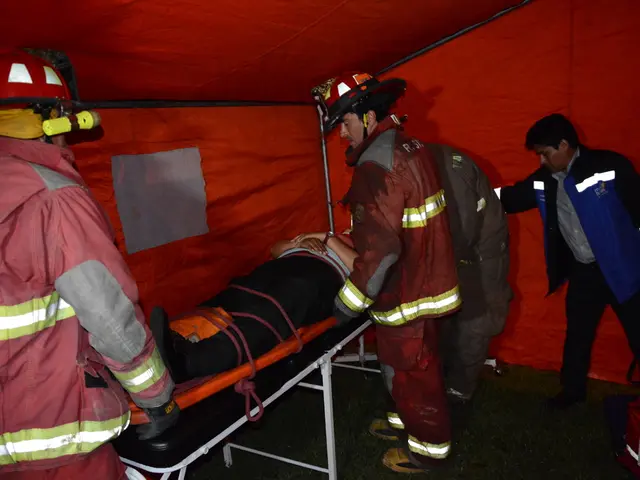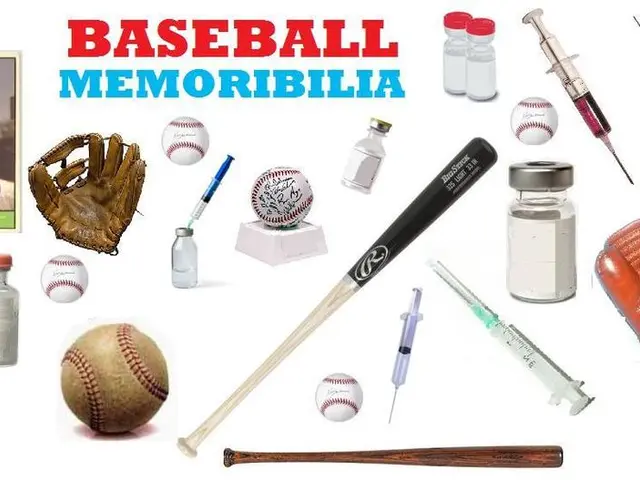Surviving in Water: An Explanation
Water: Friend or Foe? A Comprehensive Guide to Surviving Water-Related Disasters
Whether a refreshing sip from a chilly spring on a hike or a perilous plunge into icy waters, water can be both a lifesaver and a menace. To ensure you're prepared for all water-related calamities, be it a frigid lake, a sinking vehicle, or a devastating flood, understanding water survival is vital for everyone.
Mastering Cold Water Survival: The 1-10-1 Rule
Immersing in waters below 60°F can be hazardous. The body plunges into a frosty fright during cold water immersion, just as intense as it would be at 35°F. For that reason, those who play or work around cold water need to keep the 1-10-1 Rule close to heart. The rule dictates that after immersion in cold water, you have about 1 minute of cold shock followed by approximately 10 minutes before hypothermia sets in, causing death, usually within an hour.
This stage might last for 2-3 minutes if you're adequately prepared, thanks to prior training.
Maintaining composure and exercising higher cognition is the key to survival during the first few minutes of cold water immersion.
Overtunning the Cold Shock Effect
In the initial stage of cold water immersion, your body responds by hyperventilating. Tragically, this is when many cold water fatalities occur, even among strong swimmers, due to inhaling water if unprepared for the icy shock.
Lip-Pursing Breathing – a technique that reins in breath control - can help you regulate air intake and regain mastery over your body. Focus on drawing long, deep breaths through pursed lips until you've regained control of your breath.
Braving the Bite of Cold Water
After the body acclimates sufficiently to stop hyperventilation, you enter a phase lasting between 5-15 minutes. This period is crucial for survival preparation since boating enthusiasts should don life jackets to boost their chances of survival as hypothermia sets in, rendering their limbs useless.
Breaking Free from Cold Water Immersion: Self-Rescue Techniques
In the event of falling through ice, kick your legs to swim back onto a surface. Always exit the water in the same direction you entered to avoid confusing the ice and breaking through. Once out of the water, assume a hands-and-knees posture to distribute your body weight and minimize the risk of breaking the ice.
The Icy Escape: Facing Failure
If self-rescue proves futile, aim to get as much of your body out of the water as possible to prevent hypothermia. This could involve bracing your arms against the ice to freeze them, thereby preventing sinking, or using debris to float. The goal is to keep yourself afloat until you lose consciousness.
If you're wearing a life jacket in open water, remember HELP to conserve body heat:
- Heat: Create heat by rubbing hands together, shaking, or using any other method available.
- Escape: Attempt to find a means of getting out of the water.
- Lessening: Conserve your energy and avoid unnecessary movement.
- Posture: Stay in a fetal position to reduce heat loss.
A chill will claim a life in as little as 45 minutes at water temperatures below 35°F. This duration can extend somewhat, but unconsciousness will have set in by 15 minutes after cold water immersion.
The Race Against Time: Rescuing a Cold Water Victim
In this desperate stage, the only hope lies in assisted rescue, but even then, survival is not guaranteed. A sturdy rope equipped with a simple slipknot can be wrapped around the victim's body, securing them under their armpits, to pull them out. Rescuers should prioritize their own safety by avoiding falling into water or breaking through ice themselves.
A Snug Wrap: Combating Hypothermia in Cold Water Victims
If you come across an unconscious cold water victim, act swiftly to combat the effects of hypothermia. A makeshift hypothermia wrap can be created using the following steps:
- Spread a tarp on the ground.
- Add cushioning to the tarp.
- Stack three sleeping bags on the pad.
- Replace the victim's wet clothes with dry ones.
- Place the victim in the middle sleeping bag.
- Put hot water bottles in their armpits and crotch.
- Swaddle them in the tarp like a burrito.
- Send them to a hospital immediately.
Escape Artist: Surviving Vehicle Submersion
8-10% of drownings in the US occur in vehicles, making it essential to act swiftly and correctly to survive these situations. Remember these four vital steps to safely escape a submerging vehicle:
- Snap: Remove seat belts instantly.
- Break: Roll down or break the vehicle's window.
- Carry: Transfer children to the front seat.
- Bail: Escape through the window.
An Emergency Escape Tool: The Window Breaker
It's advisable to keep a dependable center punch or window breaker in your vehicle. Doors won't open in water due to water pressure, and the best escape route is always through a rolled-down or shattered window.
The Deluge: Surviving a Flood
Floods are the number one cause of weather-related deaths in the United States, as they occur in every U.S. state and territory.
Flood Preparedness: A Plan for the Worst
Being vigilant and well-prepared is the most effective way to survive any disaster. Creating a flood plan is crucial, and there are numerous ways to tackle this task.
Seek Solace: Escaping Flood Waters
Getting to higher ground is crucial when escaping flood waters. In hilly regions like the Colorado Rockies, this can be achieved by scrambling up mountains and hills during heavy rain. In urban areas, seeking refuge on building and vehicle roofs is a common strategy.
The ultimate Survival Kit: The Bug-Out Bag
Keeping a bugout bag prepared is always a good idea, especially in areas prone to flooding. Stay alert and ready to evacuate at a moment's notice when a flood threatens. Having a pre-packed survival kit will make escaping disasters easier, safer, and more comfortable.
Dancing with Floodwaters
Never attempt to cross floodwaters, no matter how shallow or slow they may appear. If you find yourself caught in a flood, swim against the current with your feet pointed downstream while keeping your face above water. Use debris for support if available, and keep your feet level with the water to avoid entanglement.
The Bottom Line
Outdoor activities come with inherent risks, but understanding water survival can help minimize these perils. Go for training, and remember these vital water survival tips:
- The 1-10-1 rule for cold water survival will help you overcome cold shock.
- Break windows to escape sinking vehicles within the first minute of immersion.
- Have flood plans, and get to higher ground to avoid floodwaters.
- In the face of cold water immersion, employing the lip-pursing breathing technique aids in regulating air intake, thereby helping to regain control over one's body.
- When drowning in open water, adhering to the 'HELP' strategy can help conserve body heat, which is crucial for survival during cold water immersion.
- In both wilderness and urban settings, the ability to escape flood waters by getting to higher ground is essential for survival, as floods remain the leading cause of weather-related deaths in the United States.
- For those who work or recreate around cold water, mastering the 1-10-1 Rule and being adequately trained can help increase the chances of survival in water-related disasters and promote overall health and wellness through fitness and exercise in outdoor settings, including science-based wilderness adventures.






